Brazilian name: papa-formiga-cantador
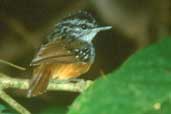
In January 2007 the Auk published a paper by Mort and Phyllis Isler and Bret Whitney entitled "Species Limits in Antbirds (Thamnophilidae): The Warbling Antbird (Hypocnemis cantator) complex." The Auk 124(1):11-28, 2007. The conclusion of the paper is that six populations of Warbling Antbird currently considered subspecies are more appropriately recognised as species, given the multiplicity of vocal differences that distinguishes them.
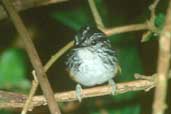
The six species they distinguish are:
Guianan Warbling-Antbird Hypocnemis cantator
- eastern Venezuela, the Guianas and Brazil north of the Amazon and east of the Negro
Imeri Warbling-Antbird Hypocnemis flavescens
- southern Venezuela and adjacent areas of Brazil around the upper rio Negro.
Peruvian Warbling-Antbird Hypocnemis peruviana
- most of the western Amazon Basin, west of the lower rio Negro and the rio Madeira.
Yellow-breasted Warbling-Antbird Hypocnemis subflava
- the extreme south-west of the Amazon Basin in Peru and Bolivia.
Rondonia Warbling-Antbird Hypocnemis ochrogyna
- Brazil east of the rio Madeira in Rondonia and adjacent areas of Bolivia
Spix's Warbling-Antbird Hypocnemis striata
- Brazil south of the Amazon and east of the middle and lower Madeira.
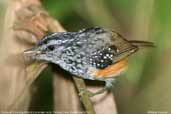
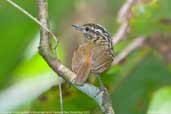
Their appearance varies. Spix's Warbling-Antbird has strongly marked black and white upperparts in the male and is quite rufescent on the flanks. Peruvian Warbling-Antbird is deep rufous on the flanks with more dark spots on the underparts and is generally darker. Imeri Warbling-Antbird has a hint of yellow on the underparts and browny-grey wings.
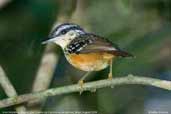
Refer to the Cat. nr. on the right and listen to the male songs of cantator on 8610 and 11999 and of striata on 11368. These songs accelerate. Compare them to the songs of flavescens on 11392, peruviana on 4784 and 12075 and subflava on 2530. These songs decelerate. The remaining species ochrogyna has a relatively even spaced song as you can hear on 1895. In this recording of a duet, as in several others, you can also hear the female song, a descending series of 6 to 9 notes.
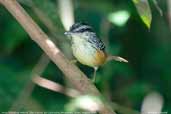
| Previous Page | Back to Index | Next Page |